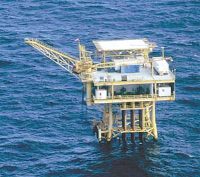South America: Trinidad and Tobago
August 2000 Vol. 221 No. 8 International Outlook SOUTH AMERICA Stuart Wilkinson, Contributing Editor Trinidad And Tobago
SOUTH AMERICAStuart Wilkinson, Contributing Editor Trinidad And TobagoIn the first nine months of last year, the economy expanded by 5.7%, while inflation fell to 3.4%, down from 5.6% in the previous year. The energy sector represents about one-fourth of the country’s GDP. The country is the Caribbean’s largest oil and gas producer. Exploration. Late last year, Shell, operator of Block 25a for partner Agip, spudded the first exploration well in its deepwater offshore licenses. The well, drilled in 3,531-ft waters, had a target TD of more than 9,900 ft, setting a water-depth record in the area and starting a frontier exploration phase in the country’s deep waters. Calgary, a subsidiary of Trans-Dominion Energy Corporation (72.5% stake), was issued a joint license with Petrotrin (27.5%) for an extensive exploration project covering the South West Peninsula. The exploration program will include 3-D seismic and a minimum of two exploration wells. Further wells are to be drilled to develop an oil-bearing sand identified earlier in well Bonasse 2. The JV is unique in that it encompasses both onshore and offshore acreage. BHP and partners, Elf and Talisman, made another gas discovery with their second exploration well, Aripo 1, in the Block-2C production sharing contract area.
Development. Compared to most of Latin America, Trinidad’s drilling was remarkably stable. This year, as a testimonial to the country’s very active E&P sector, drilling is set to rise 48%. Early this year, the government gave the green light for two gas-liquefaction trains, each with a capacity of 3 million t/yr. Added to the Atlantic LNG unit at Port Fortin, the country’s total productive capacity would rise to more than 9 million t/yr by 2003. The cost of the two trains, $1.12 billion, will be funded by BP Amoco, Repsol-YPF and British Gas (BG). When operational by third-quarter 2002, BG will be able to supply half of one train’s feedstock from its North Coast Marine Area fields. Gas for train 3 and the rest of train 2 will come from BP Amoco’s East Coast fields. The two new trains are to be built at the existing site at Port Fortin. BP and Repsol are cooperating in an LNG-import terminal and associated power venture at Bilbao, Spain. Repsol will import all the output from train 3 and half the output from train 2. BP Amoco has been licensed to distribute gas within Spain. Production. Crude reserves, estimated at 686 million bbl, are expected
to last only a decade, but hopes are to raise oil production to 200,000 bpd between 2005 and 2010.
|
- Applying ultra-deep LWD resistivity technology successfully in a SAGD operation (May 2019)
- Adoption of wireless intelligent completions advances (May 2019)
- Majors double down as takeaway crunch eases (April 2019)
- What’s new in well logging and formation evaluation (April 2019)
- Qualification of a 20,000-psi subsea BOP: A collaborative approach (February 2019)
- ConocoPhillips’ Greg Leveille sees rapid trajectory of technical advancement continuing (February 2019)



